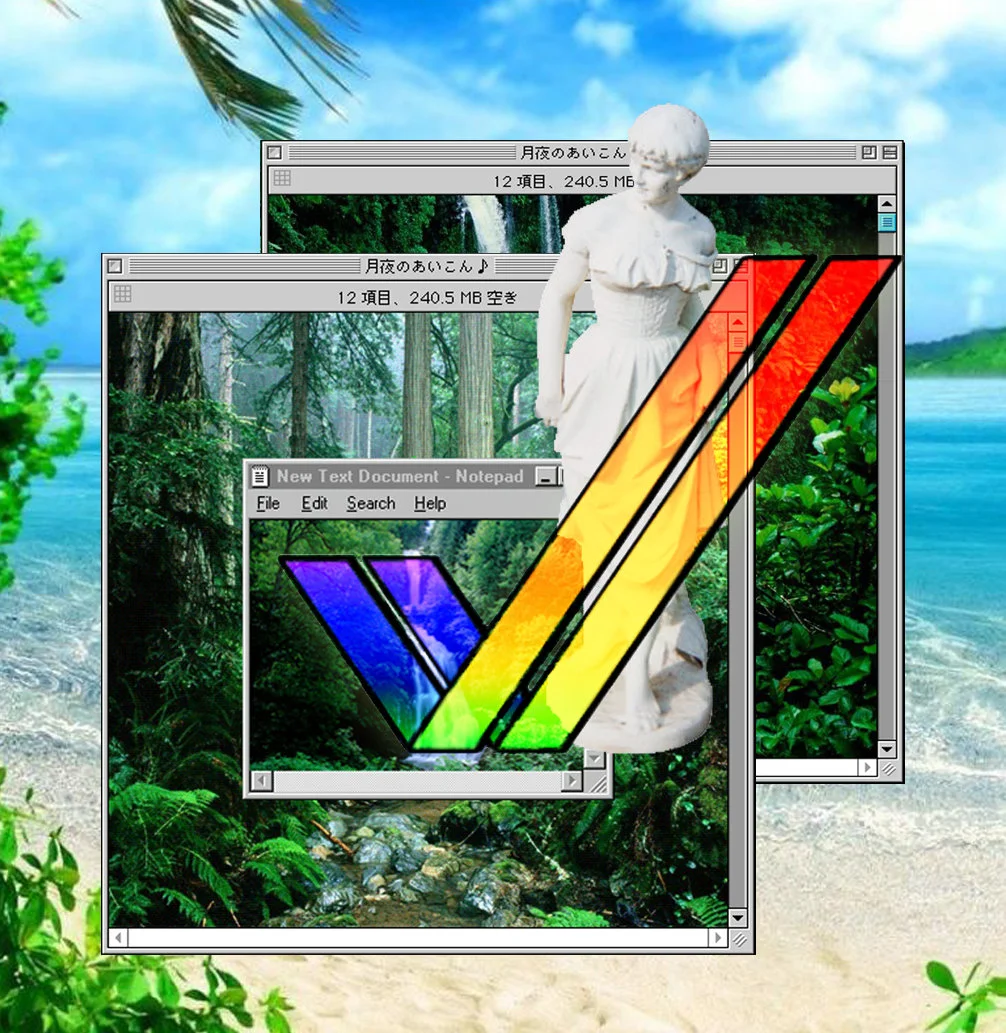Article by: Jake Stevenson
The entire music industry has ground to a halt. Tours and festivals have been postponed or cancelled, people are unemployed, and there is a pervasive sense of uncertainty, boredom, and concern in the music community. If you’re stuck inside wondering what to do to relax, or need some different music to listen to, I enthusiastically suggest the misunderstood electronic microgenre of vaporwave.
The mere mention of vaporwave prompts one of two responses: “what is that?” or perhaps more commonly “isn’t that meme music?” Well yes, but actually no. While there are plenty of articles and videos explaining some of vaporwave’s history, music theory, meme origins, and nostalgic aesthetic, here I present a modern guide for its many niche subgenres and how vaporwave’s constant evolution will ensure it remains a viable format rich with both social commentary and minimal escapism well into the future.
Floral Shoppe by Vektroid, under the alias Macintosh Plus, is widely touted as the album that pushed vaporwave into the public consciousness, among other similarly sounding releases from the record label Beer on the Rug. Although the song titles are written in Japanese, the album’s most recognizable track, known as “Lisa Frank 420 / Modern Computing,” is a heavily slowed and chopped sample of the “It’s Your Move” cover by Diana Ross.

The landmark video racked up over 40 million views on YouTube before it was taken down over copyright issues. And while the echoes Macintosh Plus’ Floral Shoppe have risen to be a recognizable pantheon of memes, it certainly does not represent the genre as a whole, merely a representation of its beginnings. This track became a poster child for early vaporwave, emblematic of the genre’s ironic portrayal of the 80s and 90s and it’s iconic aesthetic of basic computer images, bright colors, and pop culture references – like 9/11’s Twin Towers in the background.
Vaporwave has come a long way since Floral Shoppe, and can be considered both a microgenre of electronic music as well as its own macro genre rife with specific subgenres. Vaporwave feels both like an entirely new type of music and also one you’ve heard before, because the music is so effectively escapist with samples from familiar sources put over slick lo-fi beats.

The concept that most modern vaporwave aims to achieve is called “hiraeth,” defined in the description of the album HIRAETH by the legendary Cat Corp. as “a homesickness for a home to which you cannot return, a home which maybe never was; the nostalgia, the yearning, the grief for the lost places of your past.”
While not all vaporwave aims for nostalgia specifically, most vaporwave aims to build a soundscape of escape by referencing lost places of the past (seen in numerous pop culture samples) or by creating something so effectively nostalgic it feels like a lost memory, despite being completely new. This core concept of complete immersion in a soundscape via hiraeth champions much of vaporwave’s viable evolution into the future across its myriad subgenres.

The ambient side of vaporwave is called slushwave, with albums such as Birth of a New Day by 2814, Gateway 2000 by MindSpring Memories, and ☯️ by desert sand feels warm at night. Each one creates a magical musical environment to get lost in, whether it’s the neon nights of Tokyo in Birth of a New Day, the ethereal glimmering ocean of Gateway 2000, or the sprawling sands of ☯️. Fall asleep, meditate, relax, whatever you want – slushwave is your world to explore.
Want to go window shopping without leaving your seat? Mallsoft is the subgenre for you, using background noise from packed malls of yesteryear to achieve hiraeth. There’s no better album to embody the subgenre of mallsoft than Cat Corp’s Palm Mall. The soothing synths will leave you mesmerized, and if you’re up for more, there’s Palm Mall Mars, or perhaps Hantasi’s Vacant Places.

If you’re looking for disco’s vaporwave cousin, look no further than the future funk subgenre. Bae, and its follow-up Bae 2 are the definitive albums for this style of vaporwave, pioneered by the artist Yung Bae. At times more subdued than disco and at other times like a delightful and driving trip that seems like a vaporwave version of Madeon, Bae and Bae 2 are iconic albums that couldn’t be more future funk if they tried.
These albums are perfect for putting a smile on your face, and Bae 2 even boasts features from the likes of Luca Lush and josh pan. And remember the claim that vaporwave continues to evolve using pop culture samples – look no further than Yung Bae’s most recent work of art, a flip of the “5PM” melody from the hit video game Animal Crossing: New Horizons.

If future funk isn’t your electronic style, there’s also vaportrap, which features shimmering synths over slick trap beats. Blank Banshee boasts an extensive library of this subgenre, and VAPERROR’s album Mana Pool might be the best in this category.
A personal favorite subgenre, and perhaps the weirdest, is signalwave, sometimes called broken transmission. Signalwave approximates its sounds from radio broadcasts, television programs, television stations, and whatever else can be unearthed for successful sampling. Cat Corp’s incredible Sunday Television is a perfect example, being built around distorted samples from the Weather Channel while delivering groovy lo-fi beats. Admittedly it’s one of my favorite albums of all time and certainly supplies a fun first listen.

If your sample tastes skew more Eastern, the works of asutenki consistently provide beautiful sounds masterfully mixed with samples from Japanese television and radio programming. Typhoon is a standout album, perfect for relaxation and social distancing.
Another niche subgenre of vaporwave which draws from 90s pop culture is Lucien Hughes’ brainchild, Simpsonwave, based on the lovable family cartoon The Simpsons. As you may have guessed, Hughes pairs a vaporwave soundscape with carefully selected and edited footage from the famous cartoon. S U N D A Y S C H O O L might be the quintessential Simpsonwave video, but there are dozens more available on Hughes’ YouTube channel.
Speaking of YouTube, the way you consume vaporwave is almost as important as what vaporwave you consume, and of course it’s entirely up to personal preference. Since vaporwave’s prominence, ironically, is tied to physical formats whose prominence seems long past, most hardcore connoisseurs prefer cassettes, vinyl, minidiscs, and on rare occasion compact discs. Since vaporwave CDs are a rarity and minidisc players are scarce, analog is typically the way to go and cassettes offer an antiquated hum in the background which sets the nostalgic mood perfectly. And as modern vaporwave releases increasingly turn to limited edition cassettes and vinyls, their colorful designs have become increasingly gorgeous.
For simply streaming vaporwave, mixes are most widely available on YouTube, but hosting is inconsistent since videos are removed all the time due to copyright and other issues. As a result, Bandcamp is the true central hub to listen and purchase vaporwave on the internet. Whether it’s an artist or a label, digital releases seem to be more secure on Bandcamp, while physical album releases range from the sizable (500+ units) to a size so small it sells out in minutes (50 – 100 units).
No matter the medium, most vaporwave albums have unique art for each of the tracks, as the artist works to match the audio soundscape with a visual one. The ability to view the accompanying art with each track is something the vaporwave community values highly about Bandcamp. And it must be said that the vibrant vaporwave community continues to fuel the genre.
It used to be a running joke back around 2016 that vaporwave was dead, but a passionate and active community helped to maintain the music’s growth and reshape its modern viability. Like we’ve seen, an artist could release a new album so different from anything before, it spawns a whole new subgenre. Successful vaporwave artists then create their own labels, which in turn provide room for more fresh talent to develop.
Iconic vaporwave albums have seen physical re-releases on prettier vinyls and cooler cassettes, offering fresh opportunities for a new fan base. All the while, vaporwave persists to be a critique on consumerism, a haven for nostalgia, an irony-laced musical accompaniment to memes, an incredibly effective form of escapism, and an increasingly broadening horizon of unexplored ideas.
The world needs music – music that inspires, and right now, music that serves as an escape. Like all genres, vaporwave is not for everyone, but given this extensive primer, maybe you’ll find yourself diving into its rich soundscape and nostalgic aesthetic.













